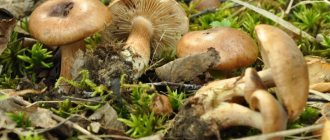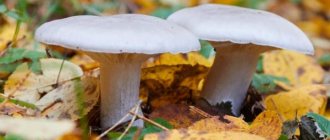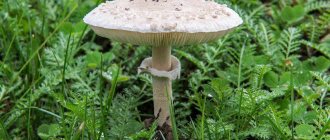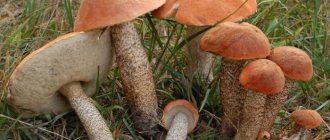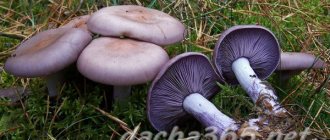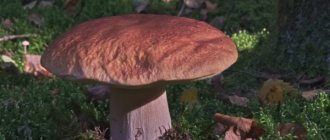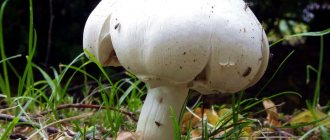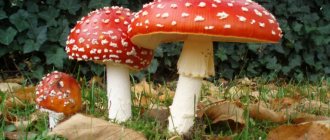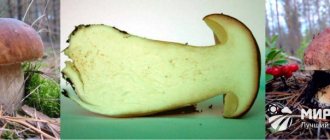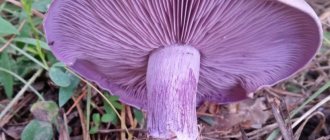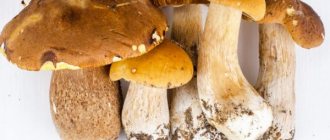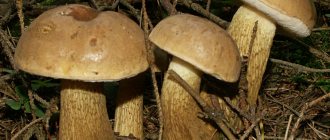Characteristic features of the species and collection rules
The genus includes species of all mushroom categories: from edible to poisonous. The rows are characterized by the following general features:
- a fleshy convex cap that acquires a flattened shape as it ages;
- cracked edges;
- presence of records;
- cylindrical leg;
- thick pulp;
- powdery odor in many species.
It is best to collect paths in the first half of autumn. It is not difficult to look for mushrooms, because they grow in a row and in large groups. You can distinguish edible and poisonous species by appearance, smell or reaction of the pulp to air.
Attention!
You cannot break the mycelium - the paths must be cut with a knife. A broken mushroom place leads to the death of an entire family.
How to distinguish
Every mushroom picker going on a quiet hunt for row mushrooms must remember the golden rule - edible row mushrooms emit practically no odor, they are dangerous to health - they frankly stink with an incomprehensible chemical “composition”. Experts and agronomists strongly recommend harvesting only after the first acquaintance with the plant has occurred and the person already has an idea of what fruits he needs. The minimum that needs to be done is to go to the Internet and study from photos what edible mushrooms look like (besides this, it should be stately, massive, neat).
Next, we will take a closer look at the appearance of the plant, depending on its variety.
Which species are considered completely edible?
Autumn edible rows are represented by the following types:
- Dove (dove). Doves have white, fleshy caps with a cracked edge. They are shaped like a hemisphere. The surface is slippery and sticky. The leg is curved. The surface of the stem is white, but specimens with a greenish base can be found. The plates are wide and white.
- The yellow-brown species is distinguished by a convex velvety cap. Reddish scales are densely located on the yellow-brown surface. The leg is curved, thickened at the base. It always matches the color of the hat. The mushroom plates have a lemon tint.
- The young reddened row has a convex hat, but as the mushroom matures it takes on a flatter shape, and a tubercle protrudes in the center. The surface is sticky, scaly, red-brown in color. The leg is thickened towards the bottom. It is white above and yellow-red below. The pulp is white or yellowish with a characteristic mealy aroma.
- The tortoiseshell has a fleshy cap with a slippery red-brown surface. Initially it is convex, but as it matures it takes on an irregular, prostrate shape. The edges of the cap are thin, with multiple cracks, the stem is wide and fleshy. As the row grows older, it changes its color from white to brown. The pulp is white and does not change color in air. She smells pleasantly of freshly ground flour.
- The gray species is distinguished by an ashy cap with a lilac tint. The surface is smooth and slippery. The leg is thickened towards the base. Its surface, white with a yellowish tint, is covered with a powdery coating. The plates are sinuous, painted white.
- Matsutake has a small brown cracked cap, from under the skin of which white flesh is visible. The leg is dark brown, elongated. It is very difficult to get out of the soil. The pulp has a mushroom aroma.
- Ryadovka Mongolian looks like a champignon. The hat is hemispherical or egg-shaped. As it ages, it may stretch out a little. The edges are curved inward. Young mushrooms have a white and shiny cap, while old mushrooms have a gray and matte cap. The leg is widened at the base, strewn with large white or cream scales.
Ryadovka Mongolian
RESPONSIBILITY
RESULTS °ss RELEASE 3-9 CONDITIONS. RESULTS ÑÑÑ Ð¿Ð»Ð¾Ñко-вÑпÑклой, а в ÑеÑедине оÑÑаеÑÑÑ Ð¾ÑÑÑ Ñова ÑÑй бÑгоÑок. RESULTS › RESULTS AND RESPONSIBILITIES RUSSIAN RESEARCH, RESULTS-ORDER ¸ землиÑÑого ÑвеÑа. registry registry 1/2 ¿Ð¸ÑÑ. RESULTS ой напоÑвенной и землиÑÑо-ÑеÑой.
Conditionally edible row mushrooms
The category of conditionally edible mushrooms includes the following types of rows:
- silver (scaly sebaceous);
- golden;
- shod;
- scaly (sweetheart);
- yellow-red;
- bearded;
- greenfinch.
On the territory of Russia the most common are:
- The scaly row has a convex or flat-convex cap. A tubercle is visible in the middle. The surface of the hat is velvety, chocolate-colored. The leg is club-shaped. It is white on top and pink-brown or yellow-brown below. The pulp can be either white or creamy. At the break, a faint fruity aroma wafts from it.
Scaly row - The yellow-red row is distinguished by a yellow-orange surface of the cap, completely covered with scales of a purple or red-brown hue. Initially, the shape of the cap is convex, but over time it becomes flat. The surface is dry and velvety. The leg is often curved. It has a pronounced thickening at the base. The leg matches the color of the hat. It is also densely covered with scales, the shade of which is a shade lighter than the cap scales. The flesh of the mushroom is yellow, with an unpleasant sour odor.
Row yellow-red - The bearded one has a conical cap with a pronounced tubercle in the center. Its surface is pinkish-brown or reddish-brown in color. In the center the color tone is slightly darker. The leg widens towards the top. Below it has a red-brown tint, and above it is pure white. The pulp has no distinct smell or taste.
Bearded Row - Greenfinch is distinguished by the green color of its fruiting body. The hat is convex, grassy or yellow-green in color. There is a tubercle in the middle. As mushrooms age, scales appear on the surface of the cap. The leg is wide, short, colored in the color of the cap. The plates are bright lemon in color. The pulp is white with a characteristic powdery odor.
Greenfinch
RESPONSIBILITY
конеÑно же, инÑеÑеÑÑеÑ, где ÑаÑÑÐµÑ Ñ Ñдовка. RESULTS I'm sorry. RESULTS ·Ð¾Ð²Ð°ÑелÑми. RESULTS ¹Ð½Ñе деÑевÑÑ: в оÑновном ÑоÑнÑ, Ñедко â елÑ, п¿ иÑÑÑ Ð¸ ли SOS. RESULTS й, дÑбом и бÑком. RESULTS RESULTS.
RESULTS › › ROOM ÑÑ Ñже веÑной.
Inedible rank and file
The following types of rows fall into the category of inedible mushrooms:
- white-brown (white-brown);
- broken;
- stumpy;
- rough;
- soapy;
- dark;
- different (separate);
- sulfur (sulfur-yellow);
- pointed.
On our territory, broken, rough, dark and isolated species are extremely rare. Let us consider in detail the common inedible species:
- The white-brown row has a flattened cap with a tubercle and wavy edges. The surface is mucous. It may have a wine brown or reddish brown hue. Dark veins are visualized across the entire surface of the cap. The edges are pale. There is always a white spot on the velvety pinkish-brown leg. The pulp is white and smells like flour.
White-brown row - The honey-shaped row has a convex cap with wavy edges. The surface is fibrous, heterogeneous in color. The color is represented by veins and spots of the following shades: red;
- yellow;
- olive;
- brown. The plates of the fungus are intertwined and covered with dark spots. There is a woolly ring on the leg. Above it, the surface of the leg is beige, and below it is white with brown scales.
Ryadovka acumenia
Sulfur row
Soap row
Pointed row
Use in cooking
This is a tasty edible mushroom that belongs to the fourth category. Not everyone likes its mealy smell, but it can be easily eliminated by heat treatment. Before cooking, the May mushroom must be cleaned of dirt and debris and boiled for about half an hour.
In cooking it is used for:
- frying,
- pickling,
- marinating.
Mushrooms in French
Products:
- 0.5 kg of May mushrooms,
- 120 g sunflower oil,
- a quarter liter of white wine,
- about 300 g beef broth,
- 300–350 g ham,
- 8 slices of bread.
Three stages of preparation:
- Pour half the oil into a saucepan and saute the mushrooms, cut into strips, in it.
- Next, simmer them in the same frying pan, gradually adding broth in small portions. At the end, add wine and simmer the mushrooms in it for a few more minutes.
- Lightly fry the ham pieces in butter, place the prepared rows on them and serve with bread croutons.
Kalotsibe with feta cheese
Products:
- 300 g mushrooms,
- 35 g butter,
- 150 g cheese,
- egg,
- salt,
- pepper.
Preparation:
- Fry thoroughly cleaned and washed mushrooms in sunflower oil, adding salt and pepper.
- When the mushrooms are fried, add the egg and cheese and continue the process until the mushrooms are ready.
This dish goes very well with boiled or fried potatoes.
Fried rows
Products:
- 1 kg of fresh rows,
- three carrots and onions,
- salt,
- spices,
- greenery.
Preparation, three steps:
- Thoroughly clean the mushrooms of debris, rinse and boil for about 15 minutes.
- Sauté finely chopped onion and carrots in vegetable oil.
- Add the rows to the vegetables and continue to simmer for 15 minutes.
Stuffed May mushrooms
Products:
- 10 large mushroom caps,
- lemon juice,
- 15–20 olives,
- 3 cloves of garlic,
- 100 g bone marrow,
- 120 g herring,
- 1 tbsp. spoon of butter,
- spices,
- salt.
Preparation:
- Wash the mushroom caps under running water.
- Pour water into the pan to a third of its volume and bring to a boil. Add lemon juice to the water, place the prepared caps and simmer over low heat for about five minutes.
- Remove the mushrooms from the container, dry them on a paper towel, add salt and pepper.
- Filling: pit the olives and finely chop them along with the garlic. Mash the bone marrow and anchovies with a fork and mix with the olives.
- Place the caps in a greased baking dish and fill each with the resulting minced meat. Place the mold in the oven, heated to 170–200 degrees and bake the mushrooms for 15–20 minutes.
Poisonous species and differences from edible ones
Ingestion of poisonous row plants is very dangerous for human health. These include the following types:
- spruce;
- white;
- toad;
- smelly;
- conical (pointed);
- brindle (leopard);
- spotted;
- scorched (tanned).
Edible species can only be confused with white, spotted and leopard rows. You can distinguish them like this:
- The white row is distinguished by its snow-white, sometimes yellowish color. The hat is spread out and velvety. The leg is cylindrical, slightly curved. Its surface repeats the color of the cap. You can recognize a mushroom by its pulp. It tends to change its color when in contact with air, so when broken it instantly turns pink. The pulp emits a sharp, unpleasant odor of radish.
White row - The cap of the spotted rower is spread out and slippery, with a small depression in the middle. It is painted light brown. Dark brown longitudinal stripes and spots of the same shade are clearly visible across the entire surface. The edges of the cap are slightly lighter. The leg is widened at the base. From below it repeats the color of the cap, and from above it is white.
Spotted rower - The leopard row is easily recognized by the characteristic leopard pattern on the surface of the cap: dark gray spots appear on a light gray background. The color fades a little along the edges. The hat has an open shape. The leg is white, thickened towards the bottom.
Leopard print row
Toxic or downright poisonous “brothers”, which are dangerous
Every self-respecting mushroom picker should be familiar not only with useful forest gifts, but also have an idea of false fruiting bodies - so as not to mistakenly put them in the basket with the harvest. Since our article is devoted to the study of the row mushroom, we present to your attention a description of the fruits of the family that are not suitable for consumption.
White (smelly) row
A poisonous plant that is strikingly reminiscent of the champignons we all know. It emits a very strong chemical stench and also has an unpleasant taste (it burns and imparts bitterness to the taste buds). Grows in colonies under deciduous crops. Like all the varieties discussed earlier, the mushroom cap is at first semicircular, later it becomes prostrate. The diameter of the “head” is up to 12 centimeters, the height of the leg is up to 10. The color of young mushrooms is gray, every day it changes more and more closer to brown, and alarming spots appear. The plates are white-yellow, darkening with aging. They appear from the ground in August, disappearing with the onset of cold weather.
Soap mushroom
It is worth noting that technically such a row is not dangerous to health, since it is not “endowed” with toxins, but not everyone can eat such a delicacy. The main problem of the fruit is its unpleasant taste, reminiscent of ordinary decorative soap, which does not disappear even after prolonged heat treatment. The color is green, dotted with alarming red spots, the diameter of the cap reaches 13 centimeters. The stem is dense, white-green in color, the height ranges from 5 to 13 cm. The flesh is elastic, thin; if the mushroom is broken, it will take on a red tint. Prefers to “neighbor” with coniferous trees from August to November.
Pointed or mouse row
A frankly poisonous plant with a sharp “effect”, growing among pines and other conifers. A distinctive feature is a hat that resembles a small bell. The skin is thin, iridescent, hiding the gray flesh. The leg is white, with a slight gray coating, can reach 16 centimeters and expand closer to the ground. Old mushrooms often develop rusty spots, making the poisonous mushroom even more dangerous if eaten. The pulp has virtually no odor.
Beneficial features
Mushrooms can lower blood cholesterol levels
Representatives of different species belonging to the genus Ryadovka contain vitamins A, group B, PP, E. The pulp contains thiamine and riboflavin, as well as useful trace elements calcium, magnesium, potassium, sodium, copper, phosphorus, zinc. Chitin and fiber contained in the cell walls cleanse the intestines of toxins.
Forest gifts are not a low-calorie product; they quickly fill you up. Per 100 g from 30 to 40 kcal. The pulp contains almost no fats and carbohydrates; most of the mass is occupied by water and protein. Forest species contain all types of amino acids (including essential ones) that humans need for normal life.
Row mushrooms when consumed regularly:
- strengthen the immune system;
- lower cholesterol levels in blood vessels;
- improve vision;
- work as antioxidants;
- lower blood sugar levels.
Growing methods
Row mushrooms are often grown at home in closed greenhouses or in garden plots. You can simply plant them yourself by digging up forest soil with mycelium:
- The mycelium is mixed with soil on the site in a ratio of 2:1.
- Mycelium is planted in autumn at temperatures below +15℃.
- For better aeration, mushrooms need to be kept in order.
- To create the necessary conditions, the beds are protected from the sun and rain.
- When new mycelium forms, soil is added.
- After each harvest, it is necessary to add fresh soil.
Where do they grow?
It is important for anyone interested in preparing delicious mushroom dishes to know where the rows grow. They are most often found in types of areas characterized by sandy soils covered with moss. They grow mainly in coniferous forests and pine forests, which is why they are often called pine trees. In addition, rows often grow in parks and gardens. The very name of these mushrooms suggests that they grow in rows, which are often quite long.
It should be borne in mind that representatives of different varieties of rows prefer different habitats. For example, Mayweed can be found not only in coniferous forests, but also in deciduous forests, as well as in meadows and fields.
